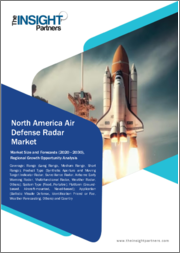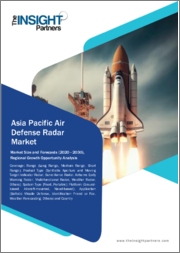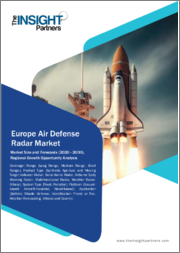
|
시장보고서
상품코드
1603563
목표 지정 레이더 시장 보고서 : 동향, 예측 및 경쟁 분석(-2030년)Target Designation Radar Market Report: Trends, Forecast and Competitive Analysis to 2030 |
||||||
목표 지정 레이더 동향 및 전망
세계 목표 지정 레이더 시장의 미래는 공군, 해군, 육군 시장에 기회가 있고 유망한 것으로 보입니다. 세계 목표 지정 레이더 시장은 2024년부터 2030년까지 연평균 7.3%의 성장률을 보일 것으로 예상됩니다. 이 시장의 주요 촉진요인은 첨단 방위 시스템 및 기술에 대한 수요 증가, 지정학적 긴장과 군사비 증가입니다.
- Lucintel의 예측에 따르면, 유형별로는 2좌표 레이더가 예측 기간 동안 높은 성장세를 보일 것으로 예상됩니다.
- 용도별로는 공군이 가장 높은 성장세를 보일 것으로 예상됩니다.
- 지역별로는 아시아태평양이 예측 기간 동안 가장 높은 성장을 보일 것으로 예상됩니다.
목표 지정 레이더 시장의 전략적 성장 기회
목표 지정 레이더 시장은 기술 발전과 국방 수요의 진화로 인해 풍부한 전략적 성장 기회를 제공하고 있습니다. 군사 작전이 점점 더 정교 해짐에 따라 강화 된 표적 및 감시 능력에 대한 수요가 증가하여 기술 혁신과 투자의 길을 열었습니다. 중요한 기회 중 하나는 레이더 시스템에 인공지능과 기계 학습을 통합하는 것입니다. 이러한 기술은 표적 식별, 추적 및 상황 인식을 향상시켜 군대가 동적 위협에 더 효과적으로 대응할 수 있도록 도와줍니다. 또한 다양한 역할을 수행할 수 있는 다기능 레이더 시스템의 추세는 기업이 국방 기관의 비용을 절감하고 운영을 간소화할 수 있는 다재다능한 솔루션을 개발할 수 있는 잠재력을 제공하고 있습니다.
- 신기술과의 통합 : AI와 머신러닝을 첨단 센서 융합 기술과 함께 목표 지정 레이더에 통합할 수 있는 여지가 있습니다. 이러한 통합을 통해 기존 레이더에 AI 및 머신러닝 기능을 추가하고 목표물 인식 능력을 강화하여 목표물 추적의 정확도를 향상시킬 수 있습니다. 이를 통해 다른 첨단 센서와의 통합을 통해 종합적인 상황 인식을 제공함으로써 더 나은 의사결정과 더 효과적인 조준을 가능하게 합니다.
- 다기능 레이더 시스템 개발 : 다기능 레이더 시스템은 SAR/GMTI와 같은 여러 역할을 수행할 수 있습니다. 이러한 시스템은 단일 플랫폼에서 감시, 정찰, 조준에 사용할 수 있는 유연한 솔루션을 제공합니다. 이를 통해 여러 개의 전용 레이더를 구매할 때보다 비용을 절감하고 운영의 유연성을 높일 수 있습니다.
- 신흥시장 진출 : 방위력 강화에 대한 수요가 증가하고 있는 신흥시장 진출은 레이더 제조업체에게 전략적 기회입니다. 국방력 현대화에 투자하고 있는 국가들은 첨단 목표 지정 레이더의 잠재적 고객입니다. 기업은 경쟁력 있는 가격으로 맞춤형 솔루션을 제공하여 매출을 늘리기 위해 이러한 시장을 공략해야 합니다.
- 휴대용 및 이동식 레이더 시스템 강화 : 다양한 전술적 상황에서 사용할 수 있는 휴대용 및 이동식 레이더 시스템에 대한 수요가 증가하고 있습니다. UAV, 차량 및 기타 휴대용 장비에 탑재할 수 있는 소형 및 경량 레이더를 개발함으로써 이러한 요구를 충족시킬 수 있습니다. 이러한 제품은 기동성과 다재다능함을 향상시켜 현대 군사 작전에 적합하며 시장 전망을 향상시킬 수 있습니다.
목표 지정 레이더의 전략적 성장 전망에는 신흥 기술과의 통합, 다기능 레이더 시스템 개발, 신흥 시장으로의 확장, 휴대용 레이더 솔루션 강화 등이 포함됩니다. 이러한 기회는 끊임없이 변화하는 국방 환경에서 시장 성장, 기술 혁신 및 경쟁을 촉진할 것입니다.
목표 지정 레이더 시장의 촉진요인 및 과제
목표 지정 레이더 시장은 성장과 개척을 형성하는 다양한 주요 촉진요인 및 과제에 영향을 받고 있습니다. 군사 작전이 더욱 복잡해지고 정밀 조준에 대한 수요가 증가함에 따라, 이러한 원동력을 이해하는 것은 이해관계자들에게 필수적입니다. 주요 촉진요인으로는 목표물 식별 및 추적 능력을 크게 향상시키는 인공지능 및 머신러닝과 같은 첨단 기술의 통합이 있습니다. 전 세계적으로 진행되고 있는 군비 현대화는 보다 효과적이고 효율적인 작전을 가능하게 하는 정교한 레이더 시스템에 대한 수요를 더욱 부추길 것입니다. 그러나 시장은 엄격한 규제 요건과 다양한 방위 시스템 간의 상호 운용성 요구와 같은 큰 도전에 직면해 있습니다. 또한, 사이버 보안에 대한 우려와 레이더 시스템의 적대적 악용 가능성은 지속적인 위험을 초래하고 있습니다.
시장 성장 촉진요인:
- 레이더 기술의 발전 : 레이더 기술의 발전 : 신호 처리 강화 및 위상배열 레이더와 같은 기술의 발전으로 레이더의 정확도, 사거리 및 범용성이 향상되었습니다. 현대의 국방 활동에는 최첨단 레이더 시스템이 필요하며, 이는 이 기술의 지속적인 진화를 통해 가능해졌습니다.
- 국방 예산 증가 : 세계 국방 예산의 증가는 목표 지정 레이더 시장의 확대에 영향을 미치고 있습니다. 군사 현대화와 첨단 무기에 대한 투자 증가는 첨단 레이더 시스템에 대한 수요를 촉진하고 있습니다. 각국 정부는 더 나은 표적 정확도와 상황 인식을 위한 레이더 업그레이드 등 국방 능력 향상을 위해 추가 예산을 배정하고 있습니다.
- 현대전 통합 : 목표 지정 레이더와 드론, 자율주행차 등 현대전 시스템과의 통합은 중요한 원동력입니다. 레이더 능력을 다른 첨단 시스템과 결합하여 작전의 효율성을 높이고 종합적인 상황 인식을 제공하여 정밀 조준과 군사 효율성을 향상시킬 수 있습니다.
- 지정학적 긴장 고조 : 첨단 레이더 시스템에 대한 수요는 지정학적 긴장과 지역 분쟁의 증가에 의해 주도되고 있습니다. 안보 위협과 분쟁에 직면한 국가들은 목표 지정 레이더를 포함한 방위 기술 업그레이드에 투자하고 있습니다. 불안정한 지역에서 감시 및 표적화 능력을 향상시켜야 할 필요성이 시장 성장을 촉진하고 레이더 설계의 기술 혁신을 촉진할 것입니다.
시장에서의 도전 과제:
- 높은 개발 및 유지보수 비용 : 목표 지정 레이더 시스템의 개발 및 유지보수 비용이 높다는 점이 문제점으로 지적되고 있습니다. 첨단 레이더 기술 조사는 정기적인 유지보수 및 업그레이드와 함께 많은 투자를 필요로 합니다. 이러한 비용은 국방 계약업체에 따라서는 구매 가격에 영향을 미칠 수 있고, 사용의 용이성을 제한할 수 있습니다.
- 기술적 복잡성 : 목표 지정 레이더 시스템의 기술적 복잡성도 문제입니다. 첨단 레이더 기술 개발에는 전문적인 기술과 자원이 필요합니다. 이러한 복잡성은 개발 기간의 장기화, 기술적 문제, 프로젝트 일정 및 비용의 지연을 초래할 수 있습니다.
- 전자전에 대한 취약성 : 목표 지정 레이더는 재밍, 스푸핑 등 전자전 전술에 취약합니다. 적들이 전자적 대응 수단을 사용하여 레이더의 기능을 방해할 수 있는 능력은 레이더의 효율성을 떨어뜨립니다. 그러나 전자전에 대한 내성을 강화한 레이더 시스템을 개발하는 것은 어렵고 지속적인 기술 혁신이 필요합니다.
목표 지정 레이더 시장은 기술 발전, 국방 예산 증가, 최신 시스템과의 통합, 지정학적 긴장 고조 등의 영향을 받고 있습니다. 그러나 높은 개발 비용, 기술의 복잡성, 전자전에 대한 취약성, 규제 제약 등 시장 개척은 큰 도전에 직면해 있습니다.
목차
제1장 주요 요약
제2장 세계의 목표 지정 레이더 시장 : 시장 역학
- 소개, 배경, 분류
- 공급망
- 업계 성장 촉진요인과 과제
제3장 시장 동향과 예측 분석(2018-2030년)
- 거시경제 동향(2018-2023년)과 예측(2024-2030년)
- 세계의 목표 지정 레이더 시장 동향(2018-2023년)과 예측(2024-2030년)
- 세계의 목표 지정 레이더 시장 : 종류별
- 2 좌표 레이더
- 3 좌표 레이더
- 세계의 목표 지정 레이더 시장 : 용도별
- 공군
- 해군
- 육군
제4장 지역별 시장 동향과 예측 분석(2018-2030년)
- 세계의 목표 지정 레이더 시장 : 지역별
- 북미의 목표 지정 레이더 시장
- 유럽의 목표 지정 레이더 시장
- 아시아태평양의 목표 지정 레이더 시장
- 기타 지역의 목표 지정 레이더 시장
제5장 경쟁 분석
- 제품 포트폴리오 분석
- 운영 통합
- Porter's Five Forces 분석
제6장 성장 기회와 전략 분석
- 성장 기회 분석
- 세계의 목표 지정 레이더 시장 성장 기회 : 종류별
- 세계의 목표 지정 레이더 시장 성장 기회 : 용도별
- 세계의 목표 지정 레이더 시장 성장 기회 : 지역별
- 세계의 목표 지정 레이더 시장 최신 동향
- 전략적 분석
- 신제품 개발
- 세계의 목표 지정 레이더 시장 생산능력 확대
- 세계의 목표 지정 레이더 시장 기업 인수합병(M&A), 합작투자
- 인증과 라이선싱
제7장 주요 기업 개요
- Raytheon
- Northrop Grumman
- MEADS
- Rockwell Collins
- Lockheed Martin
- BAE Systems
- Thales Group
- Aerospace Nanhu Electronic Information Technology
- Glarun Technology
- Leike Defense Technology
Target Designation Radar Trends and Forecast
The future of the global target designation radar market looks promising with opportunities in the Air Force, navy, and army markets. The global target designation radar market is expected to grow with a CAGR of 7.3% from 2024 to 2030. The major drivers for this market are the growing demand for advanced defense systems & technologies and rising geopolitical tensions & military expenditures.
- Lucintel forecasts that, within the type category, two-coordinate radar is expected to witness higher growth over the forecast period.
- Within the application category, the air force is expected to witness the highest growth.
- In terms of regions, APAC is expected to witness the highest growth over the forecast period.
Gain valuable insights for your business decisions with our comprehensive 150+ page report.
Emerging Trends in the Target Designation Radar Market
The emerging trends in the target designation radar market are shaping future applications and dynamics within this industry. These trends reflect technological advancements, growing operational needs, and changing defense strategies. The target designation radar market is experiencing several emerging trends that highlight advancements in technology and shifting defense priorities. As military operations become more complex and dynamic, the demand for more sophisticated radar systems is increasing. One significant trend is the integration of artificial intelligence (AI) and machine learning (ML) into radar technologies, which enhances target identification, tracking, and situational awareness. Additionally, the focus on unmanned systems and automation is shaping the market, with radar systems being designed to support drone and robotic operations, providing real-time data for effective decision-making.
- Combined Integration of AI and Machine Learning: The integration of AI and machine learning with radar systems is a prominent trend. AI algorithms can accelerate target recognition, classification, and tracking by processing large amounts of real-time radar data. Machine learning models are regularly updated to keep up with new threats. This development enhances the efficiency of targeting systems, making them more accurate and effective in complex operational conditions.
- Radar Systems with Multi-Function Capabilities: Many countries now advocate for multi-function radar systems, which combine different types of radars, such as synthetic aperture radar (SAR) and ground moving target indicators (GMTI). These systems offer comprehensive surveillance, targeting, and reconnaissance from a single platform. Moreover, multi-function radars improve an organization's operational flexibility by reducing the need for multiple specialized systems, providing cost-effective solutions that meet modern defense needs.
- Miniaturization and Mobility: Miniaturization is one of the key trends leading to the rise of portable and deployable radars. Advances in technology have led to the creation of smaller radars that can be mounted on UAVs, small vehicles, or portable ground stations, among others. These compact versions exhibit greater mobility than their larger counterparts, making them more versatile when deployed in various tactical situations.
- Integration into Autonomous Systems: Radar systems are increasingly being integrated with autonomous systems, such as drones and unmanned ground vehicles (UGVs). By integrating radar into these machines, real-time target designation can be achieved without human intervention. These radar systems help optimize task accomplishment by ensuring constant monitoring in dangerous environments.
- Advancement of Artificial Intelligence and Machine Learning: One of the most significant trends in the target designation radar market is the integration of AI and machine learning technologies. These advancements allow radar systems to process vast amounts of data quickly and efficiently, improving target identification and tracking capabilities. AI algorithms can analyze patterns and predict potential threats, enhancing situational awareness for military personnel.
The target designation radar market is entering a dynamic phase marked by significant advancements and emerging trends that will shape its future. The integration of AI and machine learning enhances target identification and tracking capabilities, while multi-function radars streamline operations and improve efficiency. The growing reliance on unmanned systems underscores the need for advanced radar technologies that support these platforms, further enhancing operational effectiveness.
Recent Developments in the Target Designation Radar Market
The target designation radar market is experiencing a wave of recent developments that reflect advancements in military technology and changing defense requirements. As nations seek to enhance their surveillance and targeting capabilities, innovations in radar systems are becoming essential for effective military operations. One significant development is the integration of advanced signal processing techniques and artificial intelligence, which improve target identification and tracking accuracy. These technologies enable radar systems to analyze complex environments and differentiate between various targets in real time, thereby enhancing situational awareness. Moreover, there is a growing trend toward the miniaturization of radar systems, allowing for portable and versatile applications in diverse operational scenarios. This adaptability is particularly valuable for special operations forces and rapid response units.
- Advanced Signal Processing Technologies: The performance of target designation radars has been significantly improved with the advent of new radar signal processing technologies. For example, adaptive filtering, digital beamforming, and novel algorithmic processing have allowed for better detection and tracking of targets in cluttered or challenging environments. These improvements enhance the precision of targeting information used by defense applications, increasing the accuracy and reliability of radars.
- Phased-Array Radar Systems: The use of phased-array radar systems is an important development in the market. These systems employ electronically steerable antennas capable of moving the direction of a beam quickly without any mechanical movement. This enables quick target acquisition and tracking, making these radars suitable for highly dynamic combat settings such as fast-paced operations. The integration of these radars on different platforms is improving their overall performance.
- Improved Counter-Jamming Ability: Advances in radar technology have increased resistance to electronic jamming and countermeasures. Features like frequency hopping and spread-spectrum techniques ensure that radar systems remain viable despite electronic warfare threats. These changes ensure that target designation radars continue functioning under contested conditions where opponents use various forms of electronic countermeasures that could affect their performance or even reliability.
- Increased Integration with Multi-Domain Systems: There is a growing trend of merging target designation radars with multi-domain systems, which combine sensors from air, land, sea, and space-based sources. This integration gives rise to a comprehensive situational awareness framework that allows for better coordination and response to threats. It also makes sensing, communication, and decision-making much easier.
Recent developments in the target designation radar market include advancements in signal processing technologies, phased-array radar systems, improved jamming resistance, and greater integration with multi-domain systems. Consequently, the market is making strides toward better radar performance and increased operational effectiveness in modern defense operations.
Strategic Growth Opportunities for Target Designation Radar Market
The target designation radar market presents a wealth of strategic growth opportunities, driven by advancements in technology and evolving defense needs. As military operations become increasingly sophisticated, the demand for enhanced targeting and surveillance capabilities is rising, creating avenues for innovation and investment. One significant opportunity lies in the integration of artificial intelligence and machine learning into radar systems. These technologies can improve target identification, tracking, and situational awareness, enabling military forces to respond more effectively to dynamic threats. Additionally, the trend toward multi-function radar systems-capable of performing various roles-offers potential for companies to develop versatile solutions that reduce costs and streamline operations for defense agencies.
- Integration with Emerging Technologies: There is room for integrating AI and machine learning into target designation radars, along with advanced sensor fusion technologies. This integration can improve the accuracy of target tracking by adding AI and machine learning capabilities to existing radars, enhancing their target recognition abilities. This enables better decision-making and more effective targeting by providing comprehensive situational awareness through integration with other advanced sensors.
- Development of Multi-Function Radar Systems: Multi-function radar systems are capable of performing multiple roles, such as SAR/GMTI. These systems provide flexible solutions that can be used for surveillance, reconnaissance, or targeting from a single platform. This reduces the cost compared to purchasing several specialized radars and increases operational flexibility.
- Expansion into Emerging Markets: Expanding into emerging markets, where there is an increasing need for enhanced defense capabilities, is a strategic opportunity for radar manufacturers. Countries investing in modernizing their defense capabilities are potential customers for advanced target designation radars. Companies should target these markets by offering tailored solutions with competitive pricing to boost sales.
- Enhancement of Portable and Mobile Radar Systems: There is a growing demand for portable or mobile radar systems that can be used in various tactical situations. This can be addressed by creating smaller, lightweight radars deployed on UAVs, vehicles, or other portable devices. These products offer increased mobility and versatility, making them suitable for modern military operations and improving the market outlook.
The strategic growth prospects in target designation radar include integration with emerging technologies, development of multi-function radar systems, expansion into emerging markets, and enhancement of portable radar solutions. These opportunities will foster market growth, innovation, and competitiveness in the ever-changing defense environment.
Target Designation Radar Market Driver and Challenges
The target designation radar market is influenced by a range of major drivers and challenges that shape its growth and development. As military operations become more complex and the demand for precision targeting increases, understanding these dynamics is essential for stakeholders. Key drivers include the integration of advanced technologies such as artificial intelligence and machine learning, which significantly enhance target identification and tracking capabilities. The ongoing modernization of military forces worldwide further fuels the demand for sophisticated radar systems, enabling more effective and efficient operations. However, the market also faces significant challenges, including stringent regulatory requirements and the need for interoperability among various defense systems. Additionally, concerns regarding cybersecurity and the potential for adversarial exploitation of radar systems present ongoing risks.
Drivers of Market Growth:
- Advancements in Radar Technology: Advances in technology, such as signal processing enhancements and phased-array radars, have improved the accuracy, range, and versatility of these radars. Modern defense operations require state-of-the-art radar systems, which are made possible due to the continuing evolution of this technology.
- Increase in the Defense Budget: Growth in global defense budgets is influencing the expansion of the target designation radar market. Increased investments in military modernization and advanced weaponry are driving the demand for sophisticated radar systems. Governments are allocating additional funding to improve defense capabilities, including upgrading radars for better targeting precision and situational awareness.
- Modern Warfare Integration: Integration of target designation radars with modern warfare systems, such as drones and autonomous vehicles, is a key driver. Combining radar capabilities with other advanced systems enhances operational effectiveness and provides comprehensive situational awareness, supporting precision targeting and improving military efficiency.
- Increasing Geopolitical Tensions: Demand for advanced radar systems is driven by increasing geopolitical tensions and regional conflicts. Countries facing security threats and conflicts invest in upgrading their defense technologies, including target designation radars. The need to improve surveillance and targeting capacity in volatile regions pushes market growth and drives innovation in radar design.
Challenges in the Market:
- High Development and Maintenance Costs: The cost of developing and maintaining target designation radar systems is high, which poses a challenge. Researching advanced radar technologies requires significant investment, along with regular maintenance and upgrades. These costs can affect affordability and limit accessibility for some defense contractors.
- Technological Complexity: The technological complexity of target designation radar systems is another challenge. Developing advanced radar technologies requires specialized skills and resources. This complexity can cause longer development periods, technical problems, and delays in project timelines and costs.
- Vulnerability to Electronic Warfare: Target designation radars are vulnerable to electronic warfare tactics, such as jamming or spoofing. The ability of adversaries to use electronic countermeasures to disrupt radar functioning reduces its effectiveness. However, developing radar systems with increased resilience to electronic warfare is difficult and requires continuous innovation.
The target designation radar market is influenced by technological advancements, increasing defense budgets, integration with modern systems, and rising geopolitical tensions. However, the market also faces significant challenges, such as high development costs, technological complexity, vulnerability to electronic warfare, and regulatory restrictions.
List of Target Designation Radar Companies
Companies in the market compete on the basis of product quality offered. Major players in this market focus on expanding their manufacturing facilities, R&D investments, infrastructural development, and leverage integration opportunities across the value chain. Through these strategies target designation radar companies cater increasing demand, ensure competitive effectiveness, develop innovative products & technologies, reduce production costs, and expand their customer base. Some of the target designation radar companies profiled in this report include-
- Raytheon
- Northrop Grumman
- MEADS
- Rockwell Collins
- Lockheed Martin
- BAE Systems
- Thales Group
- Aerospace Nanhu Electronic Information Technology
- Glarun Technology
- Leike Defense Technology
Target Designation Radar by Segment
The study includes a forecast for the global target designation radar market by type, application, and region.
Target Designation Radar Market by Type [Analysis by Value from 2018 to 2030]:
- Two-Coordinate Radar
- Three-Coordinate Radar
Target Designation Radar Market by Application [Analysis by Value from 2018 to 2030]:
- Air Force
- Navy
- Army
Target Designation Radar Market by Region [Analysis by Value from 2018 to 2030]:
- North America
- Europe
- Asia Pacific
- The Rest of the World
Country Wise Outlook for the Target Designation Radar Market
The target designation radar market is witnessing significant developments across various countries, reflecting advancements in military technology and evolving defense strategies. As nations prioritize enhancing their surveillance and targeting capabilities, investments in advanced radar systems are rising.
- United States: Recent developments in the U.S. target designation radar market include advancements in radar signal processing and integration with autonomous systems. Radar system improvement is a priority for the U.S. military, with AI-based target tracking and identification being key areas of focus. The development of phased-array radars, which offer better precision and flexibility, is also a significant advancement. A comprehensive situational awareness framework has been a priority, achieved by integrating radar technology with other sensors, such as satellites and drones.
- China: China has made significant strides in establishing modernized target designation radar systems. These include multi-mode radars that integrate synthetic aperture radars (SAR) for tracking targets. China is also investing heavily in technologies that enable targeted ordnance deployment and long-range detection through radar systems. Additionally, miniaturized radars for UAVs have attracted substantial investment to enhance surveillance capabilities.
- Germany: Germany has seen advances in radar technologies related to reliability and range. German defense firms are working on incorporating electronic warfare capabilities into their radar systems to address new threats. Improvements in jamming resistance and resolution, including enhanced resolution features, have been made. Germany is also focused on improving interoperability with NATO radar systems to ensure the effectiveness of joint missions.
- India: India is investing in upgrading indigenous radar systems to strengthen defense capabilities. These radar systems are designed to perform optimally under various environmental conditions, producing high-resolution imagery. India's military is focusing on integrating its radar network with ground-based and airborne platforms to enhance targeting precision and response time.
- Japan: Japan has made significant advancements in target designation radars, focusing on high-resolution and multi-functional capabilities. These include new radar concepts for detecting and tracking targets in challenging environments. Japan is also developing radars compatible with its Aegis ballistic missile defense system to enhance defensive capabilities.
Features of the Global Target Designation Radar Market
Market Size Estimates: Target designation radar market size estimation in terms of value ($B).
Trend and Forecast Analysis: Market trends (2018 to 2023) and forecast (2024 to 2030) by various segments and regions.
Segmentation Analysis: Target designation radar market size by type, application, and region in terms of value ($B).
Regional Analysis: Target designation radar market breakdown by North America, Europe, Asia Pacific, and Rest of the World.
Growth Opportunities: Analysis of growth opportunities in different types, applications, and regions for the target designation radar market.
Strategic Analysis: This includes M&A, new product development, and competitive landscape of the target designation radar market.
Analysis of competitive intensity of the industry based on Porter's Five Forces model.
If you are looking to expand your business in this or adjacent markets, then contact us. We have done hundreds of strategic consulting projects in market entry, opportunity screening, due diligence, supply chain analysis, M & A, and more.
This report answers following 11 key questions:
- Q.1. What are some of the most promising, high-growth opportunities for the target designation radar market by type (two-coordinate radar and three-coordinate radar), application (air force, navy, and army), and region (North America, Europe, Asia Pacific, and the Rest of the World)?
- Q.2. Which segments will grow at a faster pace and why?
- Q.3. Which region will grow at a faster pace and why?
- Q.4. What are the key factors affecting market dynamics? What are the key challenges and business risks in this market?
- Q.5. What are the business risks and competitive threats in this market?
- Q.6. What are the emerging trends in this market and the reasons behind them?
- Q.7. What are some of the changing demands of customers in the market?
- Q.8. What are the new developments in the market? Which companies are leading these developments?
- Q.9. Who are the major players in this market? What strategic initiatives are key players pursuing for business growth?
- Q.10. What are some of the competing products in this market and how big of a threat do they pose for loss of market share by material or product substitution?
- Q.11. What M&A activity has occurred in the last 5 years and what has its impact been on the industry?
Table of Contents
1. Executive Summary
2. Global Target Designation Radar Market : Market Dynamics
- 2.1: Introduction, Background, and Classifications
- 2.2: Supply Chain
- 2.3: Industry Drivers and Challenges
3. Market Trends and Forecast Analysis from 2018 to 2030
- 3.1. Macroeconomic Trends (2018-2023) and Forecast (2024-2030)
- 3.2. Global Target Designation Radar Market Trends (2018-2023) and Forecast (2024-2030)
- 3.3: Global Target Designation Radar Market by Type
- 3.3.1: Two-Coordinate Radar
- 3.3.2: Three-Coordinate Radar
- 3.4: Global Target Designation Radar Market by Application
- 3.4.1: Air Force
- 3.4.2: Navy
- 3.4.3: Army
4. Market Trends and Forecast Analysis by Region from 2018 to 2030
- 4.1: Global Target Designation Radar Market by Region
- 4.2: North American Target Designation Radar Market
- 4.2.1: North American Market by Type: Two-Coordinate Radar and Three-Coordinate Radar
- 4.2.2: North American Market by Application: Air Force, Navy, and Army
- 4.3: European Target Designation Radar Market
- 4.3.1: European Market by Type: Two-Coordinate Radar and Three-Coordinate Radar
- 4.3.2: European Market by Application: Air Force, Navy, and Army
- 4.4: APAC Target Designation Radar Market
- 4.4.1: APAC Market by Type: Two-Coordinate Radar and Three-Coordinate Radar
- 4.4.2: APAC Market by Application: Air Force, Navy, and Army
- 4.5: ROW Target Designation Radar Market
- 4.5.1: ROW Market by Type: Two-Coordinate Radar and Three-Coordinate Radar
- 4.5.2: ROW Market by Application: Air Force, Navy, and Army
5. Competitor Analysis
- 5.1: Product Portfolio Analysis
- 5.2: Operational Integration
- 5.3: Porter's Five Forces Analysis
6. Growth Opportunities and Strategic Analysis
- 6.1: Growth Opportunity Analysis
- 6.1.1: Growth Opportunities for the Global Target Designation Radar Market by Type
- 6.1.2: Growth Opportunities for the Global Target Designation Radar Market by Application
- 6.1.3: Growth Opportunities for the Global Target Designation Radar Market by Region
- 6.2: Emerging Trends in the Global Target Designation Radar Market
- 6.3: Strategic Analysis
- 6.3.1: New Product Development
- 6.3.2: Capacity Expansion of the Global Target Designation Radar Market
- 6.3.3: Mergers, Acquisitions, and Joint Ventures in the Global Target Designation Radar Market
- 6.3.4: Certification and Licensing
7. Company Profiles of Leading Players
- 7.1: Raytheon
- 7.2: Northrop Grumman
- 7.3: MEADS
- 7.4: Rockwell Collins
- 7.5: Lockheed Martin
- 7.6: BAE Systems
- 7.7: Thales Group
- 7.8: Aerospace Nanhu Electronic Information Technology
- 7.9: Glarun Technology
- 7.10: Leike Defense Technology
(주말 및 공휴일 제외)

















